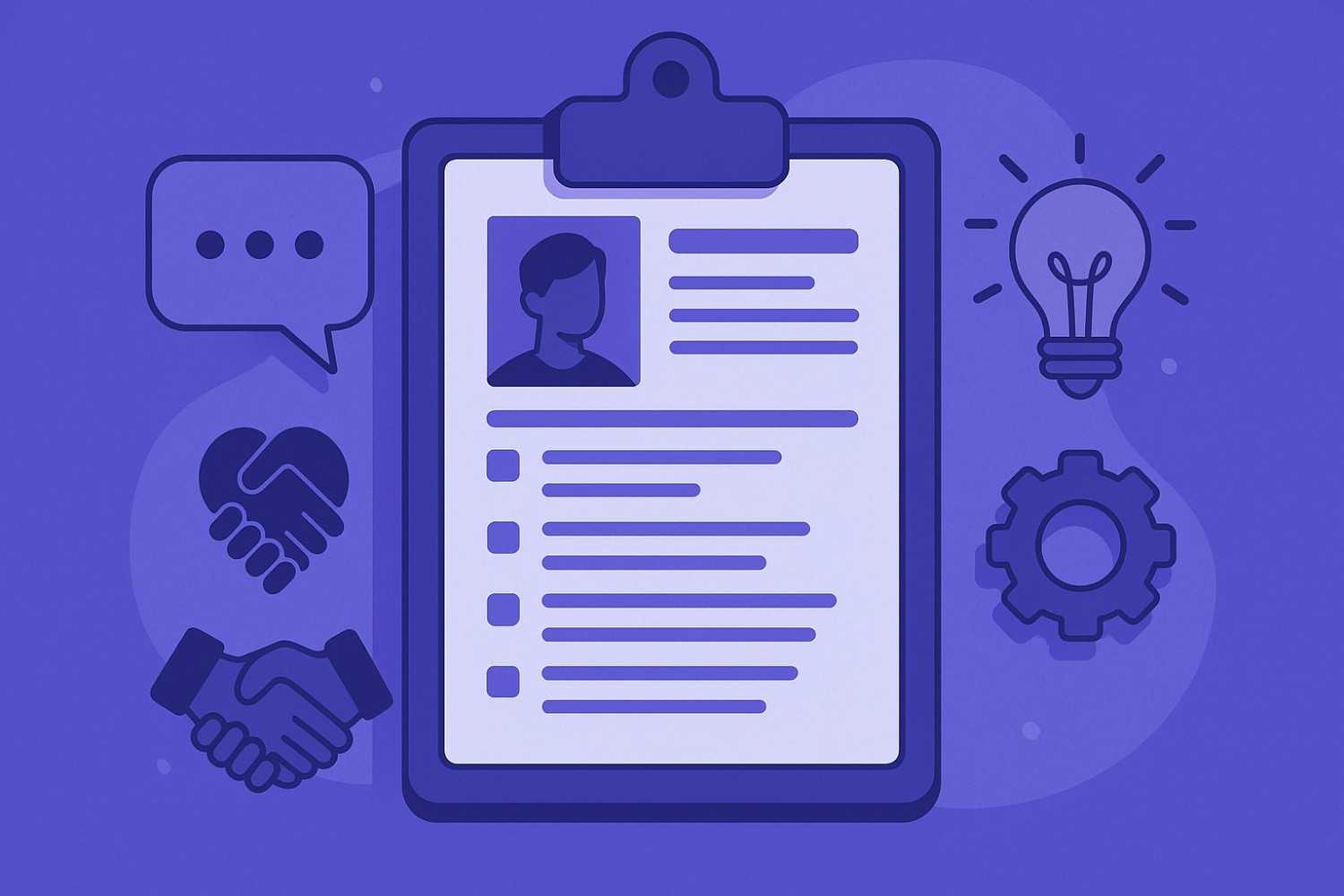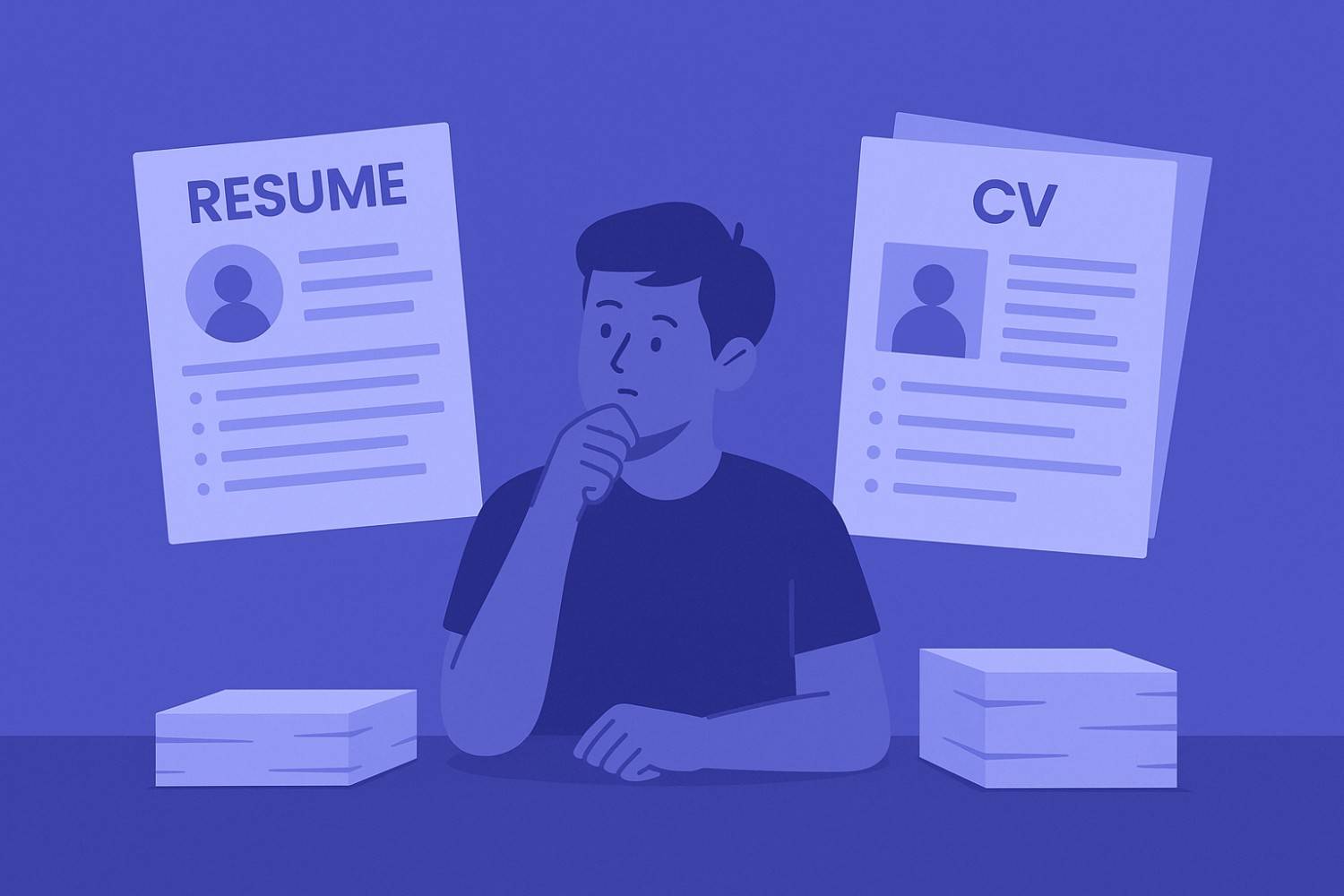Resume vs CV: What’s the Difference and When to Use Each

Discover the essential hard and soft skills to feature on your resume. Get real examples and tips to showcase your...

Understand the key differences between a resume and a CV, when to use each, and how to format them for maximum...

Learn how to craft a standout resume as a fresher with no prior work experience. Tips on formatting, sections,...

Learn how to craft a compelling resume summary or objective that grabs recruiters’ attention. Get tips, examples,...

Learn how to strategically use keywords in your resume to pass applicant tracking systems (ATS) and land more...

Learn how to write a strong resume with essential sections, examples, and tips: perfect for students, freshers, and...

Learn how to customize your resume for each job application. Improve your shortlisting chances by aligning your...

Learn the differences between chronological, functional, and hybrid resume formats. Choose the best layout based on...

Learn the most frequent resume mistakes freshers and professionals make, with tips to fix them and stand out in a...

A complete, beginner-friendly guide to writing a professional resume with clear steps, examples, and tips using a...
Resources
-

Set up personalized job alerts to receive notifications about new job openings that match your...
-

Find part-time job opportunities perfect for students, parents, and professionals seeking...
-

Work from home jobs across industries with flexible hours, competitive pay, and real career...
-

Create professional resumes with easy-to-use resume builders. Choose from templates, get...
-

Kickstart your career with internships tailored for students and graduates — explore paid,...
-

Remote jobs have revolutionized how we work, giving professionals the freedom to contribute from...
-

Find the best fresher jobs and entry-level opportunities across IT, Finance, Marketing, and...

Whether you’re applying for an internship, your first job, or a senior position, you’ve likely heard about resumes and CVs. Though they both summarize your background, their formats, lengths, and uses differ. Choosing the right document—and tailoring it properly, can make the difference between landing an interview or getting passed over.
Many applicants treat them as interchangeable, but that’s a common mistake that can cost you opportunities. This guide is designed to clear up the confusion once and for all.
In this guide, you’ll learn:
- What a resume is and when to use it
- What a CV (Curriculum Vitae) is and when it’s required
- The key differences in length, content, and purpose
- How to convert one into the other
- Best practices and tailoring tips for each format
- How JobPe’s tools can help you craft the perfect document
Why It Matters
Let's be honest, recruiters and hiring managers are busy. They often receive hundreds of applications for a single opening, and studies from platforms like LinkedIn show they spend just 6–10 seconds on their initial scan of each document. In that brief window, they are looking for one thing: relevance.
Using the wrong format or overwhelming them with irrelevant details is a fast way to get your application moved to the "no" pile. By understanding the resume vs CV distinction, you set yourself up for success.
- Present the right information in the right structure: You show the recruiter exactly what they expect to see for that specific type of role.
- Improve your ATS ranking with targeted keywords: A tailored resume is far more likely to pass through an Applicant Tracking System (ATS) than a generic CV.
- Save time by focusing on relevant content: Knowing which document to use helps you focus your efforts on what actually matters for the application.
- Demonstrate professionalism and attention to detail: Submitting the correct document shows that you understand the industry's norms and have taken the time to apply thoughtfully.
What Is a Resume?
A resume is a concise, 1–2 page summary of your education, experience, skills, and accomplishments. Think of it as a highlight reel, not the full movie. It’s designed to be a highly tailored marketing document that highlights the most relevant points for a specific job or industry.
Key characteristics of a resume:
- Length: A resume should be as short as possible. For undergraduates and recent graduates, it should be strictly 1 page. For professionals with extensive experience, it can extend to 2 pages, but never more.
- Focus: It is always tailored to a particular role or industry. A resume you send for a marketing internship will look very different from one you send for a software engineering role.
- Content: A resume typically includes:
- Contact information: Your name, phone number, professional email, and links to your LinkedIn profile or portfolio.
- Professional summary or objective: A short, 2-3 sentence statement at the top that grabs the recruiter's attention.
- Education or Experience: For freshers, the education section comes first. For experienced professionals, the work experience section is the priority.
- Skills: A dedicated section for your hard skills (like software and programming languages) and soft skills (like communication and teamwork).
- Relevant extras: This can include projects, certifications, or volunteer work that is directly related to the job.
- Format: The most common format is reverse-chronological, where you list your most recent experience first. A combination layout, which leads with a skills summary, is also popular for freshers.
- Goal: The one and only goal of a resume is to quickly demonstrate that you are a strong fit for a specific position and to get you an interview.
Pro Tip: Use our Resume Builder to select an ATS-friendly template and tailor it with keywords from your target job description. The tool can help you identify the most important skills to include.
What Is a CV?
A Curriculum Vitae (CV), which is Latin for "course of life," is a comprehensive and detailed record of your academic and professional achievements. It’s often used for positions in research, academia, medicine, or for international roles where a full history is expected.
Unlike a resume, a CV is not a summary. It is a complete, and often lengthy, account of your entire career.
Key characteristics of a CV:
- Length: A CV can span 2 or more pages, and there is no strict upper limit. For a seasoned academic, a CV can easily be 10-15 pages long.
- Focus: It provides a complete history of your education, publications, awards, and experience. It is generally static and not tailored to each specific job application.
- Content: A CV includes a much wider range of information than a resume:
- Contact information
- Education: This is a very detailed section, often including the titles of your theses or dissertations and the names of your academic advisors.
- Research experience: A full list of all your research projects, including your role and responsibilities.
- Teaching experience: Any courses you have taught, guest lectures you have given, or teaching assistant roles you have held.
- Publications, presentations, and grants: This is a critical section that lists every academic publication, conference presentation, and grant you have received.
- Professional memberships: A list of all the professional organizations you belong to.
- Awards, honors, and fellowships: Any academic or professional recognition you have received.
- Format: A CV is almost always in chronological order, with clear section headings to make it easy to navigate.
- Goal: The goal of a CV is to provide full transparency on your qualifications and scholarship, demonstrating your expertise and contributions to your field.
Academic Tip: For PhD programs or postdoctoral applications, always include your full publication list, any conference talks you have given, and a detailed teaching portfolio. Platforms like Google Scholar can help you keep track of your publications.
Head-to-Head: Resume vs CV
Use this comparison as a quick reference when deciding which document to prepare:
- Purpose
- Resume: To show your relevance for a specific job. It answers the question, "Are you the right person for this role?"
- CV: To document your full academic and professional history. It answers the question, "What is the complete story of your career?"
- Length
- Resume: Strictly 1–2 pages.
- CV: Can be 2 or more pages, and its length will grow over time.
- Customization
- Resume: It must be highly tailored for each and every role you apply for.
- CV: It is generally a static document that you update as you achieve more in your career.
- Common Uses
- Resume: The standard in the U.S. for corporate, tech, marketing, finance, creative roles, and internships.
- CV: The standard for academic positions, research grants, medical residencies, and most international job applications.
When to Use a Resume
In the United States and Canada, a resume is the default document for almost all non-academic jobs.
Choose a resume if you are:
- Applying for an internship or entry-level job (use our Internship Listings to find openings)
- Seeking roles in business, tech, sales, marketing, design, or consulting
- Targeting a specific position where you need to tailor your summary and skills for each application
- Submitting your application via a corporate Applicant Tracking System (ATS), which is designed to parse the concise format of a resume
Resume Checklist:
- ✅ Include a professional summary or objective at the top that is tailored to the job.
- ✅ Highlight relevant projects or coursework, especially if you have no formal work history.
- ✅ Use bullet points that start with strong action verbs and include metrics to show your impact.
- ✅ Optimize your resume with keywords taken directly from the job description.
- ✅ Keep the formatting clean and simple to make sure it can be easily read by an ATS.
When to Use a CV
A CV is the right choice when a comprehensive history of your academic and professional life is expected.
Choose a CV if you are:
- Applying for academic, research, or scientific positions at a university or research institution.
- Submitting to medical or healthcare programs, such as residencies or fellowships.
- Pursuing roles that require a full history of your teaching, publications, and presentations.
- Applying for positions outside the U.S., particularly in Europe, the Middle East, Africa, or Asia, where CVs are the standard for most jobs.
CV Checklist:
- ✅ List all your academic qualifications in great detail, including thesis titles, advisors, and honors.
- ✅ Include a comprehensive list of all your publications, posters, and conference presentations.
- ✅ Document any grants, fellowships, and academic honors you have received.
- ✅ Add sections for professional affiliations and any service you have done, such as committee work or peer review.
- ✅ Keep your CV updated with new achievements—remember, its length is expected to grow over time.
How to Convert Between Resume and CV
There will be times when you need to adapt one document into the other. Here’s a simple guide on how to do it.
How to Turn a Resume into a CV
- Expand your education section: Go from a simple degree listing to a detailed account. Add your thesis or dissertation titles, the names of your advisors, and any academic awards or honors you received.
- Create dedicated research and project sections: Move any key projects from your "Experience" section into a more detailed "Research" or "Projects" section.
- Add a publications list: Create a new section to list any articles, conference papers, or book chapters you have contributed to.
- Detail your presentations: Include a separate section for any poster sessions, invited talks, or panel discussions you have been a part of.
- Insert your professional activities: Add sections for any committee memberships, journal reviews, or other academic service you have performed.
How to Turn a CV into a Resume
- Trim your academic details: Condense your degrees into simple, one-line entries (e.g., “PhD in Chemistry, University of XYZ, 2024”).
- Focus only on what is relevant: Be ruthless. Keep only the experience and skills that directly match the specific job you are applying for.
- Shorten your publication list: Instead of listing all your publications, move the extensive list to an addendum or a personal website. On the resume itself, just highlight 2–3 of your most important works.
- Omit less relevant sections: Leave out things like teaching experience or affiliate memberships if they are not directly related to the corporate role you are targeting.
- Add a summary or objective: Write a short, powerful statement at the top that is tailored to the role and includes your top metrics and achievements.
Quick Hack: Create two separate master documents—one for your full CV and one for a general resume. Then, you can easily copy and paste sections as needed to create a tailored document for any application without starting from scratch.
Best Practices for Both Formats
- Use standard headings: like “Education,” “Experience,” “Skills,” and “Publications.”
- Keep the design simple: Stick to clean, easy-to-read fonts like Arial or Calibri and use bullet-style lists.
- Quantify your achievements: Use numbers to show your impact, like “Increased website traffic by 40%” or “Published 5 peer-reviewed papers.”
- Proofread meticulously: Typos and grammatical errors can cost you an interview. Use a spell-checker and ask a friend to review your document.
- Leverage JobPe tools:
- Resume Builder for ATS-optimized layouts.
- Auto-Apply to test different versions of your resume.
- Mock Interviews to practice talking about your background.
Common Mistakes to Avoid
- Keyword stuffing: Make sure every word adds value and sounds natural.
- Ignoring formatting: Unusual layouts can be rejected by ATS software.
- Including every single detail: Be selective to keep your document focused and easy to read.
- Using too much jargon: Spell out acronyms and keep your language clear for the initial HR screening.
- Forgetting to update: Regularly add your new skills and achievements to both documents.
Next Steps
- Decide which document you need for your application—a resume or a CV.
- Gather your information: Use your LinkedIn profile, transcripts, and project summaries.
- Use JobPe’s Resume Builder to create an ATS-ready resume or adapt your CV.
- Tailor the document for each application by highlighting the most relevant sections.
- Practice talking about your background with our Interview Questions tool.
By choosing the right format and presenting your experience clearly, you’ll stand out in any selection process. Good luck!
